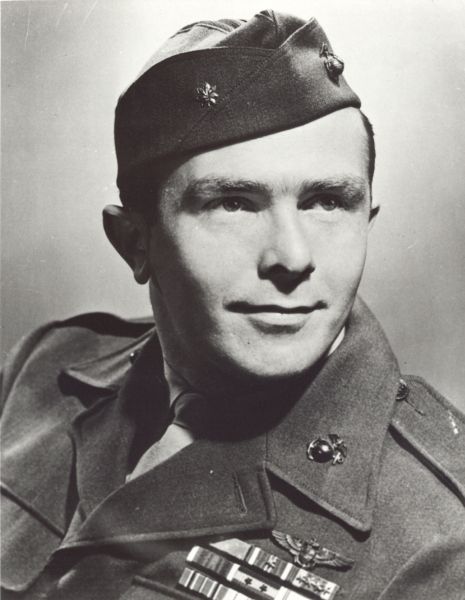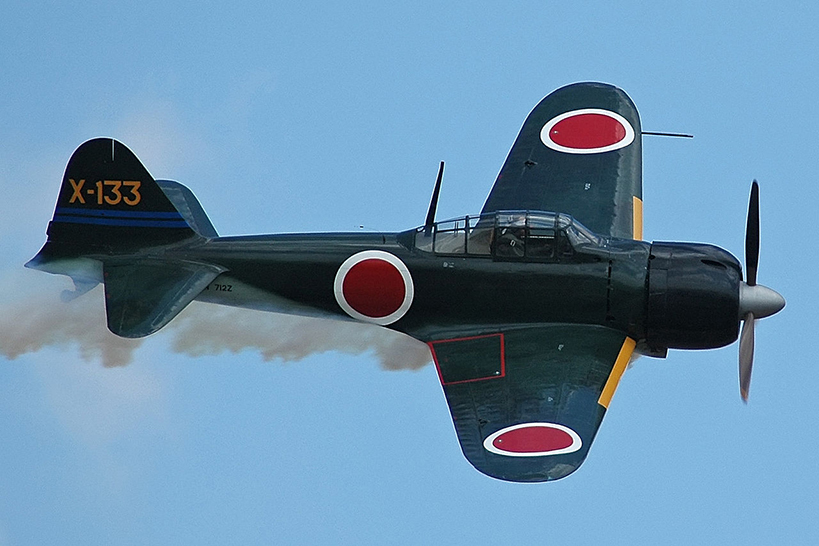Swett, James Elms
- Date of birth:
- June 15th, 1920 (Seattle/Washington, United States)
- Date of death:
- January 18th, 2009 (Redding/California, United States)
- Nationality:
- American
Biography
James E. Swet was born in Seattle, Washington on June 15th, 1920. He graduated at the San Mateo High School in San Mateo, California and enrolled from the College of san Mateo in 1939. After this he earned his private pilot’s license. On August 26th, 1941 he enlisted to teh U.S. Naval Reserve as Seaman Second Class and started his military Flight Training in September of that year.
After completing his flight training he chose to fligh with the Marine Corps. On April 1st, 1942 he was commissioned as Second Lieutenant to the NAS Corpus Christi in Texas. His advanced flight training brought him to Quantico, Virginia and Lake Michigan. His carrier qualification training he had on board the U.S.S. Wolverine and he received his wings at San Diego, California. In December 1942 he left for the Pacific and was assigned to VMF-221 at Guadalcanal as part of Marine Air Group 12. He became an ace at his first combat mission on April 7th, 1943. On this mission he also was shot down and briefly ended in hospital. Recovered he went back to his unit which moved to the Russels. Promoted to Captain he saw action over the Rendova landings on June 30th, 1943, shooting down two Japanese Mitsubishi G4M "Betty" Bombers and sharing the score for a Mitsubishi A6M "Zero". Early July he shot two other Betty’s and a Zero down over New Georgia, but was shot down himself again. After being rescued, he returned to base. In October 1943 he shot another Zero down over Kahili, Bougainville and added two Val divebombers and a fighter to his score in November.
During his leave in December he married Lois Anderson and later was transferred to NAS Santa Barbara, California to work up the newly manned and equipped VMF-221. The unit was assigned to the U.S.S. Bunker Hill. On May 11th, 1945 he shot down a Yokosuka D4Y kamikaze plane near Okinawa. Returning to the States he was assigne to MCAS El Toro in California, training for the invasion of Japan. Here he stayed until the end of the war.
During 103 combat missions in World War Two, Swett was given 15.5 confirmed victories and 4 probable.
After the Second World War he commanded VMF-141 at NAS Alameda, California. When his unit left for Korea, Swett had to stay behind. The U.S. Navy did not want to place a Medal of Honor recipient in a combat area. Swet retired form active duty as a Colonel in 1970. He then worked at his father’s company in San Francisco. Ha had taken over the company in 1960 and runned it until he retired. In 2007 he moved to Redding, California, where he died on January 18th, 2009.
Do you have more information about this person? Inform us!
- Period:
- Second World War (1939-1945)
- Rank:
- First Lieutenant (Lieutenant)
- Unit:
- Marine Fighter Squadron 221 (VMF-221), Marine Aircraft Group 12 (MAG-12), U.S. Marine Corps Aviation, U.S. Marine Corps
- Period:
- Second World War (1939-1945)
- Rank:
- First Lieutenant (Lieutenant)
- Unit:
- Marine Fighter Squadron 221 (VMF-221), Marine Aircraft Group 12 (MAG-12), U.S. Marine Corps Aviation, U.S. Marine Corps
- Awarded on:
- February 9th, 1944
SPOT Award: Serial 002176
- Period:
- Second World War (1939-1945)
- Rank:
- 1st Lieutenant
- Unit:
- Marine Fighter Squadron 221 (VMF-221), Marine Aircraft Group 12 (MAG-12), U.S. Marine Corps Aviation, U.S. Marine Corps
Second DFC warded as a golden star to be worn on the ribbon of the first DFC. (Commander South Pacific, SPOT: 001509)
- Period:
- Second World War (1939-1945)
- Rank:
- First Lieutenant (Lieutenant)
- Unit:
- Marine Fighter Squadron 221 (VMF-221), Marine Aircraft Group 12 (MAG-12), U.S. Marine Corps Aviation, U.S. Marine Corps
Third DFC warded as a second golden star to be worn on the ribbon of the first DFC.
- Period:
- Second World War (1939-1945)
- Rank:
- First Lieutenant (Lieutenant)
- Unit:
- Marine Fighter Squadron 221 (VMF-221), Marine Aircraft Group 12 (MAG-12), U.S. Marine Corps Aviation, U.S. Marine Corps
Fourth DFC awarded as a third golden star to be worn on the ribbon of the first DFC.
- Period:
- Second World War (1939-1945)
- Rank:
- First Lieutenant (Lieutenant)
- Unit:
- Marine Fighter Squadron 221 (VMF-221), Marine Aircraft Group 12 (MAG-12), U.S. Marine Corps Aviation, U.S. Marine Corps
Fifth DFC awarded as a fourth golden star to be worn on the ribbon of the first DFC.
- Period:
- Second World War (1939-1945)
- Rank:
- First Lieutenant (Lieutenant)
- Unit:
- Marine Fighter Squadron 221 (VMF-221), Marine Aircraft Group 12 (MAG-12), U.S. Marine Corps Aviation, U.S. Marine Corps
Sixth DFC awarded as a silver star to be worn on the ribbon of the first DFC.
- Period:
- Second World War (1939-1945)
- Period:
- Second World War (1939-1945)
- Period:
- Second World War (1939-1945)
- Period:
- Second World War (1939-1945)
- Period:
- Second World War (1939-1945)
- Period:
- Second World War (1939-1945)
- Period:
- Second World War (1939-1945)








